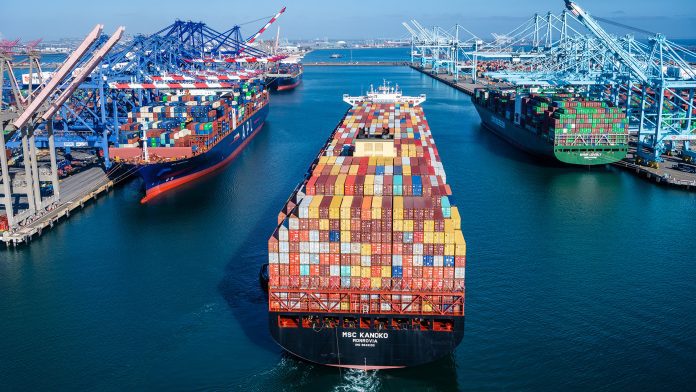
For international freight-forwarding executive Bill Rooney, the logistics and shipping crisis of 2021-22 was the worst experience of his lengthy career.

“If I added up all the mayhem over 50 years in the shipping business and multiplied it by five, it would not come close to what the world has gone through in the last three years,” said Rooney. “It has been astounding in its severity, and it has affected everybody.”
Rooney is vice president of strategic development for Kuehne+Nagel, one of the world’s leading sea, air, road and contract logistics companies. Based in Switzerland, it counts over 80,000 employees at 1,300 locations in over 100 countries, including the U.S.
Kuehne+Nagel has a dedicated sea freight service, Dried Fruit & Nuts Sea Logistics, or DFN, which handles West Coast tree nut shipments. Knud Meyer is DFN’s global development manager.

Rooney and Meyer shared their perspectives with West Coast Nut, underscoring the unprecedented impact of the pandemic-fueled shipping crisis and forecasting what tree nut growers, handlers and exporters can expect in the months ahead.
Q. What were some of the most extraordinary aspects of the logistics and shipping crisis of 2021-22?
Rooney: Global rates were up by a factor of five. All logistics activities, from the physical movement of cargo to administrative actions and things in between, were taking two to three times as long. Approximately 15% of global vessel capacity was absorbed by congestion. Unprecedented cargo volume growth challenged availability of logistics assets in the U.S. All major ports in the world had ships waiting for berthing space. The highest number for Los Angeles and Long Beach was 109 ships waiting.
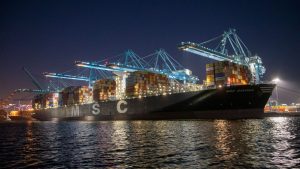
Q. How has the ocean shipping situation changed in the last six months? What’s improving, what’s not, especially for moving West Coast tree nuts overseas?
Rooney: For the non-nuts portion, things have improved a lot but are not yet fully back to pre-COVID levels. Congestion has eased significantly but has to get back to pre-COVID levels. There is no longer a container shortage.
For the portion of tree nuts shipped mainly from the U.S. West Coast, the situation has improved significantly. Last year, we saw congestion with over 100 ships waiting off Oakland and Los Angeles. The situation has since returned to normal. Services are more reliable again, scheduling is much easier and more capacity is available again on weekly departures. Right now, we are seeing some equipment challenges, especially for the Oakland area. Less equipment has come to Oakland due to lower volumes from Asia.
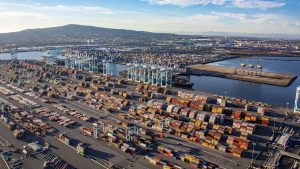
Q. What is your outlook for the logistics and shipping industry?
Rooney: Global trade growth in 2023 is likely to be flat or up very little or even down up to 2%. In my opinion, 2023 will affect the speed of the global fleet to meet new environmental requirements. The new regulations will effectively lower fleet-wide capacity by up to 15%. Carriers’ ability to control capacity, and thereby rates, via blank sailings is a significant unknown at this point.
Q. What are “blank sailings”?
Meyer: Blank sailing is when an ocean carrier cancels or skips a scheduled port in the middle of a fixed rotation. Currently, we see them especially at Oakland, which leads to challenges with equipment availability.
Q. Labor uncertainty continues at West Coast ports. What are the main issues, and how are they affecting shipments to and from West Coast ports?
Rooney: The main issues in West Coast labor, primarily through the International Longshore Warehouse Union (ILWU) and the Pacific Maritime Association (PMA), are:
Automation. The ILWU does not want to allow terminal automation because it will cost them highly paid jobs.
Union jurisdiction. The ILWU wants to take on mechanics jobs in the ports that are currently represented by the machinists union.
Money. The ILWU will want higher salaries and more expensive benefits.
The ILWU-PMA contract expired on July 1, 2022. Negotiations began on May 10, 2022 and continue with no agreement up to this point [late January 2023]. Some sources believe that an agreement will not be reached until March of this year or later. The impact on logistics is that a significant amount of cargo has moved from the West Coast to the East and Gulf coasts.
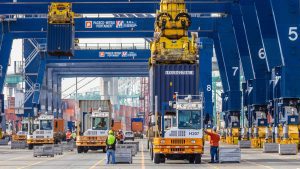
Q. What is happening with cargo volume and demand?
Rooney: Cargo volume globally declined by about 22% in late 2022 vs. 2021. Demand is down for three reasons:
In the U.S. and to an extent worldwide, consumer spending patterns are returning to pre-COVID norms. Before COVID, U.S. consumer spending was split 70%/30% on services and products. During COVID, the split went to about 66% for services and 34% for products. Spending is now moving back to the 70%/30% split.
Inflation has affected consumers’ ability to buy products, which shows up in lower cargo volume.
Lower economic activity. Global GDP growth in 2023 is expected to be about 2%. Lower GDP growth means lower trade and volume growth.
Q. What can almond and other tree nut exporters expect in the coming months regarding their shipments?
Meyer: The last two years have been challenging for all participants in the dried fruit and nuts market. This underlined how important good relationships with logistic partners are. We can see the situation for ocean freight is going back to normal. The lower volumes, however, also challenge the equipment availability. Import cargo is generally destined for the more populated urban distribution areas while the dried fruit and nuts exporters are in the valley and more rural areas, creating a natural imbalance of equipment. Schedule reliability is still low compared to pre-COVID times. But we are also seeing improvements, which is good news for tree nut exporters.
Q. Many people believe 2023 will see a slowdown in the global economy. How would that impact ocean shipping?
Rooney: Slowdown of GDP growth in 2023 could mean recessions in the U.S. and Europe. This will drive lower cargo volume globally. Lower cargo volume will mean congestion and related factors should no longer be an issue.
Q. What has Kuehne+Nagel learned from the shipping crisis?
Rooney: Everything I have said above plus carrier ability to control vessel capacity in real time will likely define the future of rates to move cargo. There is not likely to be a shortage of assets (ships, terminals, chassis, trucks, trains, rail rams) in the near-term future.
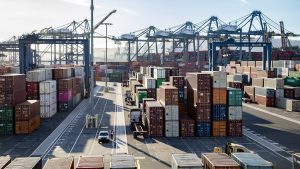
Q. Are you confident the Ocean Shipping Reform Act of 2022 will help the logistics situation?
Rooney: The Federal Maritime Commission is implementing OSRA 2022, which was signed into force by President Biden on June 16, 2022. The act will likely improve exporters’ access to purchasing assets and improve some aspects of transportation, such as clarifying the earliest return date. It will also improve and clarify the application of detention and demurrage charges. OSRA will give the FMC more enforcement authority over ocean carrier actions and define when ocean carriers practice unreasonable refusal to deal when denying to transport export cargoes. In summary, OSRA should make exporting cargo from the U.S. easier.










